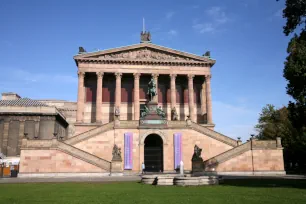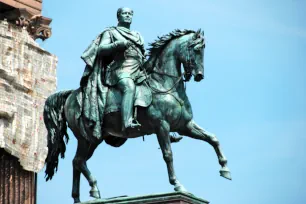The Alte Nationalgalerie (Old National Gallery) is one of a group of museums on Berlin’s centrally located Museum Island. The museum boasts a fine collection of nineteenth-century art, mainly paintings and sculptures from the German Romantic period.
Building the Gallery



Plans for the Alte Nationalgalerie can be traced back to a drawing by King Frederick William IV dated 1841. However, the credit for the design of this building goes to architect Friedrich August Stüler who imagined a temple-like structure built on a pedestal of stone.
Stüler would never get to see the building. He died in 1865, the year before work on the gallery began under the management of Johann Heinrich Strack, who oversaw the project until its completion ten years later, in 1876.
The Museum Building
Stüler’s building resembles a Greek temple. The most noticeable aspect is the magnificent portico, which consists of a sculpted pediment supported by tall Corinthian columns. Sculptures on the tympanum show Germania, the personification of the German nation, as a patron of the arts.
The temple is raised and rests on an enormous pedestal. Massive steps outside the neoclassical-style building lead to a platform in front of the portico. Though these steps were not included in William’s sketch, Stüler thought them appropriate for a building of such stature. There’s also a marvelous, sweeping staircase inside.
On the platform in front of the temple stands an equestrian statue of King Frederick William IV that was created in 1886 by Alexander Calandrelli. On the four corners of the statue’s pedestal are allegorical figures representing Religion, Art, History, and Philosophy.

The Museum after WWII
The Alte Nationalgalerie was largely destroyed during World War II. Many of the paintings and other works of art were forever gone, and some were moved to Russia. The Nazis also sold or destroyed paintings that they believed to be “degenerate”, greatly reducing the museum’s permanent collection.
Despite the massive amount of destruction, the museum was partially re-opened by 1949. However, with the political division of Germany came the division of the collection at the Old National Gallery. Eventually, after the Berlin Wall fell, the collection was reunited. And in 2001 the Alte Nationalgalerie was the first museum on Museum Island to reopen after the reunification of Germany.
The Museum Collection


The Old National Gallery is most well-known for its fine collection of nineteenth-century paintings. Many of the works are from the Romantic period, created by Prussian artists such as Franz Krüger, Carl Blechen and Caspar David Friedrich. The latter’s most famous work is probably the moody “Abbey Among Oak Trees”.
The famous Prussian architect Karl Friedrich Schinkel was also a prolific painter. His works often featured historical buildings, such as the “Gothic Church on a Rock by the Sea”, one of his best-known paintings. One of the highlights in the museum is the eerie “Isle of the Dead”, a Symbolist painting by the Swiss artist Arnold Böcklin.
The Alte Nationalgalerie also boasts the world’s largest collection of works by Adolph von Menzel, one of the most prominent German artists of the nineteenth century. Other rooms show paintings from the impressionist period, including works by famous French impressionists such as Edgar Degas, Claude Monet, Édouard Manet and Auguste Renoir.
The museum also has a collection of statues, including many works from German sculptors Christian Daniel Rauch, Johann Gottfried Schadow and Reinhold Begas. There are also some bronzes by Auguste Rodin on display.
- Next: Oberbaumbrücke
- More Sights & Attractions in Berlin

